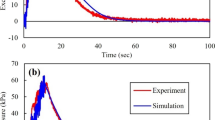Abstract
Seepage failure test means the foundation soil instability caused by underground water perturbation, which is one of the most common methods to evaluate a site seepage resistance, but it is time consuming. High water pressure is always applied to shorten the test time. However, significant error is generated as calculating the seepage failure slope (SPS), the gradient, due to the nonlinear characteristics as the pressure increases. The Darcy law and the permeability coefficient are no longer applicable. Here, an analytical method for confined aquifer is proposed to investigate the nonlinear permeability coefficient and SPS. The in situ tests were conducted on the dislocation interfaces at the reservoir banks of the Baihetan hydropower station to verify the proposed method. The test results indicate that the SPS calculated values by nonlinear equation is much smaller than that by linear equation, which means that the conventional linear calculation results will overestimate the resistance of the site seepage failure. Moreover, the results calculated by steady and nonsteady nonlinear equations are very close, while the storativity is between 1 × 10−3 and 1 × 10−5, which is the ordinary storativity of most aquifers in this region. Hence, in general, the steady nonlinear equation can be used to calculate the site SPS to simplify the calculation.







Similar content being viewed by others
References
Basak P, Madhav MR (1979) Analytical solutions to the problems of transient drainage through trapezoidal embankments with Darcian and non-Darcian flow. J Hydrol 41(1):49–57
Bear J (1972) Dynamics of Fluids in Porous Media. New York: American Elsevier Pub. Co.Dynamics of Fluids in Porous Media. New York: American Elsevier Pub. Co.
Bouwer H, Rice RC (1976) Slug test for determining hydraulic conductivity of unconfined aquifers with completely or partially penetrating wells. Water Resour Res 12(3):423–428
Camacho RG, Vásquez M (1992) Comment on “analytical solution incorporating nonlinear radial flow in confined aquifers” by Zekâi Şen. Water Resour Res 28(12):3337–3338
Choi ES, Cheema T, Islam MR (1997) A new dual-porosity/dual-permeability model with non-Darcian flow through fractures. J Pet Sci Eng 17(3):331–344
Elliott CG, Williams PF (1988) Sediment slump structures - a review of diagnostic-criteria and application to an example from Newfoundland. J Struct Geol 10(2):171–182
Ewing RE, Lin Y (2001) A mathematical analysis for numerical well models for non-Darcy flows. Appl Numer Math 39(1):17–30
Forchheimer P (1901) Wasserbewegung durch boden. Z. Ver. Deutsch, Ing 45:1782–1788
Hu S, Zhou J, Chen Y, Zhou C (2017) Laboratory research on nonlinear flow behavior of rough fractures. Chin J Undergr Space Eng 13(01):48–56
Jiang Q, Feng X, Hatzor YH, Hao X, Li S (2014) Mechanical anisotropy of columnar jointed basalts: an example from the Baihetan hydropower station, China. Eng Geol 175:35–45
Kipp KL (1985) Type curve analysis of inertial effects in the response of a well to a slug test. Water Resour Res 21(9):1397–1408
Kolditz O (2001) Non-linear flow in fractured rock. Int J Numer Methods Heat Fluid Flow 11(6):547–575
Li W, Zhou J, He X, Chen Y, Zhou C (2016) Nonlinear flow characteristics of broken granite subjected to confining pressures. Rock Soil Mech 38:140–150. (In Chinese)
Mathias SA, Todman LC (2010) Step-drawdown tests and the Forchheimer equation. Water Resour Res 46(7)
Mathias SA, Butler AP, Jackson BM, Wheater HS (2006) Transient simulations of flow and transport in the chalk unsaturated zone. J Hydrol 330(1–2):10–28
Moutsopoulos KN (2007) One-dimensional unsteady inertial flow in phreatic aquifers induced by a sudden change of the boundary head. Transp Porous Media 70(1):97–125
Quinn PM et al (2011) Using constant head step tests to determine hydraulic apertures in fractured rock. J Contam Hydrol 126(1–2):85–99
Şen Z (1987) Non-Darcian flow in fractured rocks with a linear flow pattern. J Hydrol 92(1):43–57
Sen Z (1989) Nonlinear flow toward Wells. J Hydraul Eng 115(2):193–209
Şen Z (1990) Nonlinear radial flow in confined aquifers toward large-diameter wells. Water Resour Res 26(5):1103–1109
Wen Z, Huang G, Zhan H (2008) Non-Darcian flow toward a finite-diameter vertical well in a Conflned aquifer. Pedosphere 18(3):288–303
Wen Z, Liu K, Zhan H (2014) Non-Darcian flow toward a larger-diameter partially penetrating well in a confined aquifer. Environ Earth Sci 72(11):4617–4625
Whitaker S (1996) The Forchheimer equation: a theoretical development. Transp Porous Media 25(1):27–61
Wu Y (2002) Numerical simulation of single-phase and multiphase non-Darcy flow in porous and fractured reservoirs. Transp Porous Media 49:209–240
Zhou ZF, Zhao YR, Wang JG, Zheng H (2016) A novel apparatus for obtaining in situ estimates of anisotropism hydraulic conductivity in fractured rocks. Geotech Test J 39(4): 525–531
Funding
This work was supported by the Major Program of the National Natural Science Foundation of China (Grant No. 91747204) and the Natural Science Foundation of Jiangsu Province, China (Grant No. BK20180074).
Author information
Authors and Affiliations
Corresponding author
Rights and permissions
About this article
Cite this article
Zhou, Z., Wang, Z., Li, S. et al. Determination of nonlinear seepage slope for dislocation interface by in situ tests. Bull Eng Geol Environ 80, 2765–2775 (2021). https://doi.org/10.1007/s10064-020-02081-6
Received:
Accepted:
Published:
Issue Date:
DOI: https://doi.org/10.1007/s10064-020-02081-6




